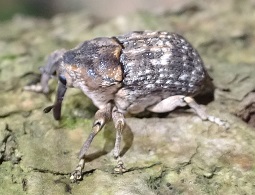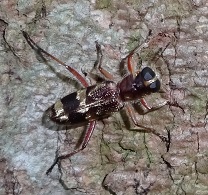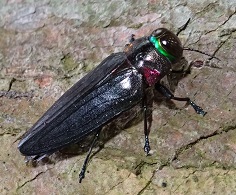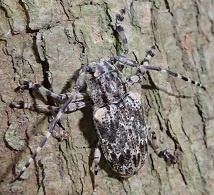| Home | Nature Weekly Index |
17 August 2014 | Fungus Beetle Larva (Episcapha quadrimacula) |
 Lately, I have been watching closely at the beetles that colonized the trunk of dead
Rubber Tree (Hevea brasiliensis). These tree trunks, 3 of them to be specific,
were still standing upright except that there was no longer any leaf on the trees.
Lately, I have been watching closely at the beetles that colonized the trunk of dead
Rubber Tree (Hevea brasiliensis). These tree trunks, 3 of them to be specific,
were still standing upright except that there was no longer any leaf on the trees.
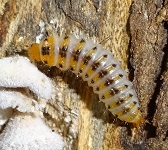
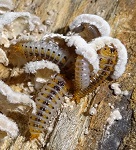 There was a type of Fungus Beetle (Episcapha quadrimacula)
that appear to be increasing in its number on these trunks over the last 2 months. This rather common beetle has 4 prominent large
irregular yellow spots on the back of its otherwise black body. The beetles were seen moving along the tree trunks feeding
on the fungus and even mating in broad daylight. This particular beetle is quite common. Early this week, I finally got to see its
larvae while I was examining in close range the fungus that the beetles were feeding on, not knowing that the larvae were also
feeding on it.
There was a type of Fungus Beetle (Episcapha quadrimacula)
that appear to be increasing in its number on these trunks over the last 2 months. This rather common beetle has 4 prominent large
irregular yellow spots on the back of its otherwise black body. The beetles were seen moving along the tree trunks feeding
on the fungus and even mating in broad daylight. This particular beetle is quite common. Early this week, I finally got to see its
larvae while I was examining in close range the fungus that the beetles were feeding on, not knowing that the larvae were also
feeding on it.
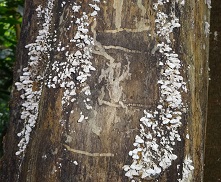
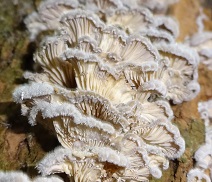 The fungus or mushroom that the beetles and its larvae were feeding on is known as
Split Gill (Schizophyllum commune). It is a very common, small,
whitish and stemless cap mushroom that usually grows in large colony. This mushroom is so common that it is available in most part
of the world and is well studied and documented. Based on some reports, the fungus may cause infection in human with compromised
immune system. Hence, do not touch the mushroom unnecessarily. To me, the exciting part was to discover its growth on the dead tree
trunk and the fungus beetle larvae that feed on it.
The fungus or mushroom that the beetles and its larvae were feeding on is known as
Split Gill (Schizophyllum commune). It is a very common, small,
whitish and stemless cap mushroom that usually grows in large colony. This mushroom is so common that it is available in most part
of the world and is well studied and documented. Based on some reports, the fungus may cause infection in human with compromised
immune system. Hence, do not touch the mushroom unnecessarily. To me, the exciting part was to discover its growth on the dead tree
trunk and the fungus beetle larvae that feed on it.
The fungus beetle is just one of several beetles that occupied the rotting tree trunk. Other common companions include longhorn beetles, jewel beetles, checkered beetle and fungus weevils. Together, these beetles and the fungus are key members in nature's recycling business. We need them to turn dead woods to reusable materials.
